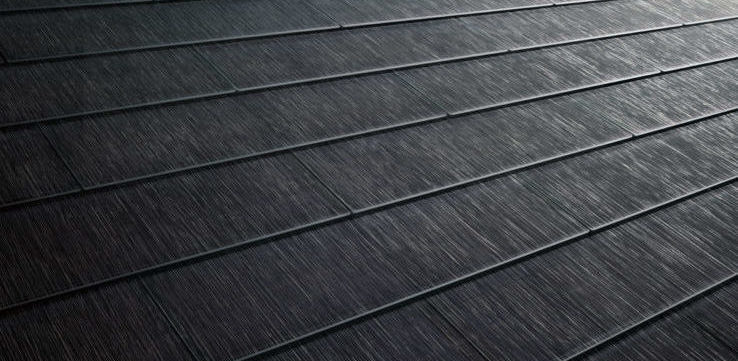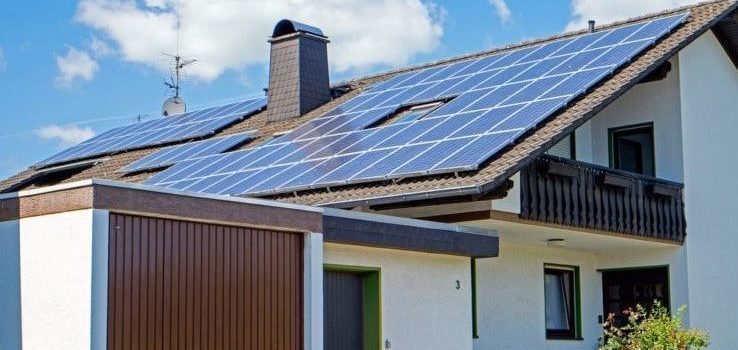Deciding Between Solar Roof Shingles or Solar Panels
Page Contents
Written by qualified solar engineer Leonardo. Last updated:
Installing solar panels is a proven way to generate your own electricity and save on power bills. However, solar roof shingles can be a viable option for new homes (or if you are planning a roof replacement). Unlike conventional panels, which are installed with racking on top of your roof, solar shingles have built-in solar cells.
On average, solar shingles are twice as expensive as panels. In the US, a solar panel system costs around $3 per watt of installed capacity, while the cost of solar roof shingles is between $5 and $7 per watt. However, consider that solar shingles also accomplish the function of a roof. While shingles are more expensive than panels by themselves, they save the cost of the roof beneath.
Consider that roof tiles have a lower efficiency than normal panels, which means you need a larger area for a given system capacity. To ensure you are getting the best deal, getting quotes from several solar roof shingle installers is recommended.
The Cost of Solar Roof Shingles

Just like with solar panel systems, the cost of solar power roof shingles varies depending on the brand and installer. For example, the cost of a Tesla solar roof is normally above $6 per watt, but there are manufacturers that offer solar tiles for less than $5 per watt. Solar roof costs are also affected by the project’s location. Since the technology is less widespread than normal panels, costs increase if there are no providers nearby.
Considering that the price of solar panel installation is around $3 per watt, you can expect to pay around $30,000 for a 10-kilowatt solar system. If you want to reach the same capacity with solar panel roof shingles, you can expect to pay between $50,000 and $65,000. Based on roof area, the installed cost of solar tiles ranges from $20 to $25 per square foot.
- Since solar tiles have twice the cost of panels for a given capacity, their payback period is also twice as long. However, solar shingles can be financially viable if you were going to pay for a new roof installation anyway.
- When choosing between solar shingles and panels, the appearance of each option also matters. If you prefer the look of solar shingles and are willing to assume the extra cost, they become an option even if you don’t plan a roof replacement.
In October 2019, Tesla revealed a redesigned version of its solar tile system called the solar glass roof. According to the company website, the estimated cost of a 10-kilowatt system is $33,950. While the price can increase depending on roof conditions and project location, this is much closer to the cost of traditional solar panels.
Do Solar Roofs Get the Federal Tax Credit Incentive?
The federal tax credit for solar panel systems is also available for solar shingle installations, making them less expensive to purchase. However, the benefit only applies for roof sections that use solar shingles. For example, if you plan to replace a 3,000-square-foot roof with 2,000 sq. ft. of solar shingles, the remaining 1,000 sq. ft. are not covered by the federal tax credit.
As of 2019, you can deduct 30% of your solar energy investment from federal taxes. However, this will decrease to 26% in 2020 and 22% in 2021. Only a 10% tax credit will remain from 2022 onwards, and it will only be available for solar energy systems in commercial buildings.
How Much Energy Do Solar Roofs Produce?
If you compare one solar tile with one solar panel, the electricity output of the panel is much higher. Solar tiles normally have a capacity below 60 watts, while many panels now have a power rating above 300 watts. To reach a certain capacity in kilowatts, the required amount of solar panels will be less compared to solar shingles.
For both solar panels and roof shingles, how much energy is produced depends on external factors as well.
- Some locations are sunnier than others. Regardless of the type of solar energy system, the electricity production increases along with sunshine. For example, California is much sunnier than New York. If you use solar shingles of the same capacity in both states, the electricity output per shingle will be higher in California.
- The orientation of solar tiles and panels is also important. In the northern hemisphere, south-facing roofs get more sunlight than north-facing roofs. If you only plan to use solar tiles in some areas, find out which sections of your roof get the most sunshine.
- Shadows reduce the productivity of all solar energy systems, regardless of their type. When defining the layout of your solar installation, shaded areas should be avoided.
A solar shingle can be described as a smaller solar panel embedded into a roof tile. The design principles used to maximize the productivity of the panels apply for shingles as well.
When Are Solar Panels Recommended Instead of Solar Roofs?

If you have no plans to build a new home or to change your roof and you are not willing to pay the extra cost of solar shingles, you can still save money by using solar panels. For example, if you recently bought a new home with a normal roof, using solar shingles is like paying for your roof twice.
Compared with solar roof installations, the time it takes to install solar panels is shorter. Solar shingles involve a partial or complete roof replacement, which can take several days, or even weeks in a large property. On the other hand, panel installations are often completed in one day. With a quicker installation, you can start saving on power bills earlier.
Before proceeding with a solar installation, take your time to contact several providers, and get familiarized with the different types of solar panels available. For example, if you have limited roof area, a solar panel model will a high efficiency will maximize the electricity output.
Solar Panels and Solar Roof Shingles: Final Comparison
The following table provides a summarized comparison between solar shingles and conventional panels. Similar to many other home upgrades, each option has advantages and disadvantages.
Features | Solar Panels | Solar Shingles |
Typical cost of a 10-kW system | $30,000 | $50,000 – $65,000 |
Wattage per unit | Over 300 watts per panel | Below 60 watts per shingle |
Installation method | Racking on top of your roof | Become part of your roof |
Service life | Over 20 years | Over 20 years |
Appearance | Visible panels | Look similar to asphalt shingles |
Recommended usage | Existing roof with no replacement plans | New constructions, roof replacements, homeowners who prefer the look of shingles and are willing to pay the extra cost |
Solar roof tiles are a higher-cost alternative to solar panels, but they combine roof tiles and panels into a single element. In new constructions and roof replacements, solar tiles can help you save on materials and installation costs.
Solar shingles can be combined with battery systems just like normal panels, to store electricity for nighttime, rainy days, or blackouts. Battery systems can also be used to participate in load management programs where utility companies offer them. The federal tax credit incentive also covers batteries if they get at least 75% of their charge from a solar energy system – this applies for both solar panels and solar shingles.
The cost of solar tiles can be expected to decrease over time as solar panels became more affordable. The new solar glass roof by Tesla is a step in this direction, bringing the cost of shingles closer to that of conventional panels.
References
- Tesla Solarglass Roof – Tesla
We hope you liked this article. Please rate it or leave us a comment.
Average rating 5 / 5. Vote count: 5
No votes so far! Be the first to rate this post.





